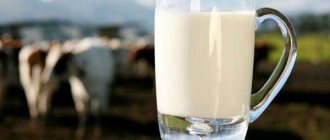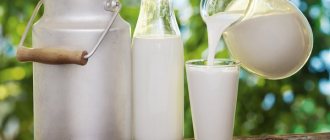Stores sell pasteurized milk. When reading the label, buyers take the information for granted, believing that such a product is harmless and does not contain pathogenic bacteria. But its composition also often raises natural doubts, especially next to the sign indicating that it is a product containing milk. Hardly anyone would call real fresh milk unecological or unnatural. However, for safety and to increase shelf life, experienced housewives use pasteurization of milk at home. Moreover, the process is simple, and with the use of a pasteurizer it is accelerated several times.
What is pasteurization
Most people have heard about the pasteurization process, but do not fully understand what it is. 150 years ago, thanks to the French microbiologist Louis Pasteur, society received not only vaccinations against rabies, cholera and anthrax, but also a way to preserve liquid products (wine, milk, drinks).
Pasteurization of milk is a one-time heating of milk to 60 °C for 30 minutes. By increasing the temperature another 10-20 degrees, pasteurization takes only 15-20 seconds. Processing time varies depending on the product, storage duration, and equipment used.
Under the influence of high temperatures, microorganisms capable of reproducing in milk die, although their spores remain viable and begin to grow again under favorable conditions. Therefore, it is recommended to store pasteurized goods at low temperatures. The advantage of the process is that it allows you to preserve the beneficial properties and taste.
Meaning
The advantages of pasteurization are obvious:
- accessible method;
- not expensive;
- the shelf life of the product increases;
- the environment is disinfected;
- the beneficial properties of the substance are preserved.
People who consume this milk are completely protected from intestinal disorders.
Effectiveness of disinfection
Pasteurization of milk is aimed at eliminating pathogenic microbes. To do this, the drink is heated once. It is mandatory to observe a certain temperature regime and focus on the holding time. Mesophilic bacteria die most quickly, but other microbes may remain active. If the liquid is stored at a temperature less than +8 degrees, it is possible to get rid of pathogenic microflora, the product becomes of high quality and useful. The development of remaining bacteria stops if the drink is stored properly.
The effectiveness of pasteurization depends on the microflora and composition of the drink being processed. For this reason, the initial quality of the product is taken into account. Subsequently, storage conditions determine the final effectiveness of disinfection. If timely cooling does not occur, microorganisms continue to develop. To increase the efficiency of heat treatment, it is recommended to cool the milk received after milking to +3 degrees to timely eliminate most bacteria. Violation of storage temperature activates the development of microflora, so pasteurization technology becomes less effective and it will be difficult to improve the microflora in the future.
To ensure a successful procedure, equipment and inventory are disinfected. If the preparation was unsatisfactory, the composition of the product will be worse due to the continued activity of bacteria. An increase in the content of enterococci in milk after pasteurization indicates unsuccessful heat treatment of the product, which remains dangerous.
Milk obtained through ultra-pasteurization can be stored without refrigeration at room temperature for up to 4 months.
Pasteurization methods
Since the invention of pasteurization, experts have varied the heating temperature, and in modern industry there are 3 methods of processing this drink.
Long-term
The most gentle method of processing milk. Pasteurization takes place automatically at enterprises. The equipment is equipped with an artificial intelligence program that does not fail. Maintenance personnel at dairy plants work around the clock, monitoring the entire technological process on monitors: heating temperature, degree of filling of tanks, time.
Treatment takes 30 minutes at 63-65 °C. During this time, all pathogenic microorganisms die, while lactic acid microorganisms remain.
Short term
This is high-temperature pasteurization - a kind of shock for the product. For 15-20 seconds the temperature in the tanks reaches 72-75 degrees.
Instant
The main factors in the process are high temperature and time.
Very quickly, in just 4 seconds, milk is processed at 130-137 °C. This is why this process is called flash pasteurization. It makes it possible to increase the shelf life of the drink indoors by up to a year.
Pasteurization occurs in pasteurizer containers, which provide rapid and short-term heating of the product, which continuously passes in a thin layer between the heating surfaces. After the procedure, the liquids are poured into hermetically sealed containers.
If the technology involves bottling milk into bags/bottles and then sterilizing it, then in pasteurizers the products are heated with steam with constant rotation.
Manufacturers do not recommend boiling pasteurized milk. During secondary processing, the nutritional value of the product and its content of vitamins A and C are reduced.
Nutrient Analysis Results
| Instant heating | Low temperature pasteurization (according to Holder) | No heating | |
| Vitamin B 12 (pg/ml) | 862.8 (667.0) | 862.3 (651.1) | 724.5 (488.0) |
| Vitamin C(mg/dl) | 4.2 (2.5) | 3.6 (2.2) | 5.3 (1.6) |
| Vitamin E (mg/l) | 2.7 (2.0) | 2.4 (1.3) | 3.0 (1.2) |
| Pyridoxal phosphate (µg/l) (n=5) | 29.0 (17.2) | 28.0 (17.4) | 28.8 (17.3) |
| Folic acid (ng/ml) (n=5) | 18.7* (3.8) | 19.0* (1.5) | 13.3 (1.2) |
| Riboflavin (µg/l) (n=5) | 728.0 (1142.9) | 704.4 (1094.5) | 667.2 (955) |
| Thiamine (nmol/l) (n=4) | 18.0 (9.1) | 17.8 (6.8) | 12.3 (4.6) |
| Lactoferrin concentration (ELISA, mg/ml) (n=10) | 0.214* (.272) | 0.826* (.246) | 1.341 (0.154) |
| Lactoferrin digestible (% absorption) (n=9) | 84 (10.1) | 80.3 (8.8) | 87.7 (12.5) |
| Lysozyme digestible (% absorption) (n=9) | 70.6 (21.0) | 75.8 (14.9) | 89.0 (14.1) |
(*p <0.05, compared to samples without heating)
Pasteurization at home
If you are not sure of the quality of milk purchased from a private seller, pasteurization will not be superfluous. The only item you will have to buy in advance is a special thermometer. In addition, you should remember at what temperature milk is pasteurized. The technology repeats the production process: thermal heating and then sudden cooling.
The procedure is as follows:
- Prepare a large container where the milk will be heated to 63-65 °C in a steam bath.
- Fill it with water about 10 cm.
- Take an enamel bowl and fill it with milk.
- Place the pan with milk in the “home pasteurizer” and wait until the water in the main container begins to boil, heating the product.
- Use a thermometer to control the temperature. Do not let the milk heat above the required temperature.
- Record the temperature, warm up for 30 minutes, then start cooling. To do this, fill the outer container with cold water and run a cold stream into it. The milk must cool very quickly; it is advisable to use ice to speed up the process.
After this procedure, there are no pathogenic bacteria left in the milk; homemade cheese can be made from it.
Buy a ready-made pasteurizer for home
If the need for pasteurization arises often or you want to make homemade cheese, you should think about buying a home pasteurizer. In appearance, it resembles a tank equipped with an electronic display, tubes, hoses and a tap. Which to choose? To begin, determine your needs:
- volume of equipment capacity;
- power;
- the presence of one or more modes;
- automatic temperature control.
The capacity of the container depends on the average amount of milk processed. On the scale of a small farm, a mini version of 15 liters will be sufficient. The presence of several heating modes is important if you plan to make cheese. It only requires slow heating. An important point is the availability of water supply and sewerage. A pasteurizer is connected to them after the milk pasteurization process is completed.
Cold water is released through the hoses to cool the finished milk. It is worth considering in advance where the pasteurizer will be installed - it needs a connection to electricity and running water.
Attention! Home pasteurizers are multifunctional equipment. You can make kefir, cheese and yogurt in them.
Available equipment from Russian factories is available for sale. In addition to the warranty receipt and passport, the packaging with the pasteurizer includes instructions detailing the technological processes depending on the needs.
Home pasteurization of milk is a process accessible to everyone. You can use the equipment available in the kitchen - a double boiler, a multicooker, or you can purchase ready-made pasteurizers. They are used to prepare homemade cheese, kefir and yogurt.
Advantages and disadvantages
Pasteurization is a desirable process in production and at home. After heat treatment, the drink is stored in the refrigerator for a long time, retains all its beneficial properties and is absolutely safe for health. The only disadvantages include the time spent on its processing and the need to control the milk pasteurization temperature.
Benefit
For the last twenty years, there has been hysteria in the world about the fact that drinking milk is harmful. Thanks to doctors, nutritionists, and biologists, this drink is regaining lost ground, because it is considered a product given to us by nature for a balanced diet. The pasteurized drink is inferior in quality to the fresh one, but is also healthy.
Its advantages are unconditional:
- low calorie content;
- suitable for baby food;
- rich in milk protein;
- one glass contains almost ½ the daily requirement of calcium;
- the composition includes minerals such as iodine, copper, strontium;
- Vitamins B and group D are present.
This product can be used by those people for whom the taste of steam is unacceptable. Skim pasteurized milk is an excellent option for those who cannot tolerate animal fats.
Possible harm
Only consuming a low-quality product can lead to negative consequences. Some unscrupulous manufacturers add chemicals to extend its shelf life.
Another possible problem is that if stored improperly, pathogenic microorganisms can begin to multiply.
Final bacterial population (Metchnikoff number)
As a result of pasteurization, it is necessary to ensure that the microbial population is quantitatively reduced to a certain minimum level. This condition is expressed by the formula:
NK < Me
Here NK is a quantitative indicator of microbial biocenosis in milk following pasteurization; Me – Mechnikov number. It represents the minimum microbial population determined by economic and technological conditions. If this inequality is satisfied, then the milk flasks will contain a healthy and safe product.
Ultra pasteurization
A type of heat treatment, also called “asepsis” or higher pasteurization. This is a process in which milk is brought to high temperatures for 2 seconds and immediately cooled to 4-5 degrees. This shock therapy kills most harmful microorganisms, due to which the drink is stored for 6 months at room temperature.
Today, two methods of ultra-pasteurization are used in production, which will be described below.
Contact
Imagine a pipe within a pipe. The liquid product passes through the inner pipe, and water heated to 125-130 °C passes through the outer pipe. When milk comes into contact with a hot surface, it undergoes heat treatment. Disinfection of juice occurs in a similar way.
Direct mixing with steam
The system involves injecting sterile steam at 135-140 °C directly into the product, and then filling it into TetraPak packaging.
Ultrapasteurization is common in the USA and a number of European countries; it is considered economical because it reduces the energy consumption of refrigeration units. In France, Spain, and Italy, such processing accounts for 95% of milk. In our country, products with a long shelf life are treated more warily; the percentage of aseptic drinks on the market is still small.
Requirements for raw materials for the production of pasteurized milk
Pasteurized cow's milk is produced from raw materials that meet the requirements of GOST 31449 and regulatory and technical documents in force in the countries that have adopted the standard.
- Marking.
Pasteurized cow's milk raw materials are labeled in accordance with the requirements or legislative, regulatory legal acts applied within the states that have adopted the standard. The marking is applied to the transport container.
It is also important that the product is accompanied by a shipping document, which must indicate:
- Name;
- identification indicators;
- name, location of the manufacturer, that is, its legal address, including the country, place of milk production, if it differs from the legal address;
- volume or mass in liters or kilograms, respectively;
- batch number;
- date and time (in hours) of the end of production;
- date and time (in hours and minutes) of shipment;
- shipping temperature;
- information about heat treatment modes, namely temperature, exposure;
- storage conditions;
- handling signs for flasks according to GOST 14192: “Keep away from sunlight”, “Perishable cargo”, “Temperature limits”;
- confirmation of compliance with the above requirements/legislative and regulatory acts;
- GOST designation.
The marking text is applied to the lid of the flask in the form of a label or tag made by printing. If milk is transported in tanks, similar information is provided in the shipping document.
Sterilization
Sterilization is the process of processing milk at temperatures above 100 °C, at which all microorganisms, their spores and enzymes are destroyed.
There are 2 types of it used in production:
- 115-120 °C for 20 minutes;
- 140-150 °C for 2 seconds.
Simply put, sterilizing milk is boiling it.
Unlike pasteurization, it takes place at very high temperatures. The process affects the chemical and organoleptic properties of milk, its taste.
Pasteur criterion
To characterize the process, the average effect of pasteurization is used for a certain theoretical (that is, according to calculation, sufficient to destroy microbes) time z. If q is the actual heat treatment time, then this parameter is equal to q/z. This value is considered an indicator of completion. If q < z, then pasteurization has been partially carried out and the microbiological purity of the raw materials is not guaranteed. There will be too many bacteria in the milk cans When q = z, the process is completely completed. In the case q > z, the necessary results were also achieved, but the work was unnecessarily lengthy.
At the suggestion of G. A. Cook, the average effect of pasteurization was called the “Pasteur criterion”, with the designation Ra.
Since pasteurization is a long process, the value of Pa depends on how the temperature of the liquid changes over time. For example, in plate devices, the destruction of microbes occurs in the pasteurization section at a critical temperature. Then - in the holding tank. After this, partially, in the recovery or regeneration section. To determine the total (integral) effect for each section, the elementary effect of the process (dq/z) for an infinitesimal unit of time (dq) is calculated. Then the integral is taken according to the formula:
Ra = ʃ(dq/z)
Pasteurization is considered complete if the total Pasteur criterion for all sections of the unit is equal to or greater than one:
Σ Ra ≥ 1
Who is not recommended to drink pasteurized milk?
Milk has its pros and cons. Its main advantage is the high content of fat-soluble vitamins, amino acids, and nutrients. It is included in many dishes: from cheeses and cottage cheese to complex desserts and sauces. This is the most accessible source of not only proteins, but also calcium necessary for humans.
Only those who have individual intolerance should avoid pasteurized milk. You also need to understand that with age, the absorption of this product worsens, since less enzymes necessary for its digestion are produced. At its core, milk is baby food, and the body does not always respond well to attempts to artificially prolong the period of infancy.
However, lactose intolerance is not always related to advanced age. In fact, intolerance to this carbohydrate greatly affected the development of human society and is still a sign on which racial and ethnic differences are built. Thus, no more than 5% of Northern Europeans cannot consume milk, while in Central Asia or among American Indians this figure reaches 100%. Interestingly, representatives of the peoples living in these territories are often forced to give up milk at 3–5 years of age.
Pediatricians' recommendations for consuming pasteurized milk
It is no secret that the baby will benefit greatly from mother's milk. Pediatricians do not agree on the age at which he can be given cow's milk. If the product does not contain antibiotics, it will not cause harm, but special milk formulas have a gentler effect on the infant’s fragile digestive system.
Doctors recommend gradually switching from formula to regular pasteurized milk at 9 months - by this time the child’s body has time to get stronger. They start with complementary feeding with cow's milk, introducing it into cereals and breakfasts in a volume of up to 150 ml per day.
After a year, they are allowed to drink up to 200 ml of milk per day. By the age of three, a child can not be limited in the consumption of this product, because we are talking about the age when the baby is actively growing and developing, his digestive system is formed and absorbs regular food well. It is better to choose milk with a low fat content (about 3%) and not try to give a low-fat product.











